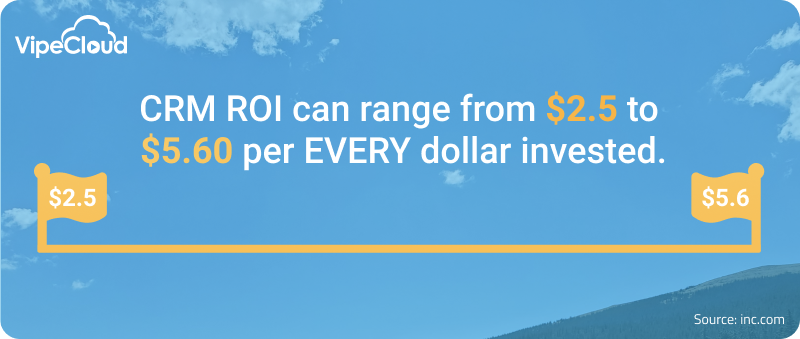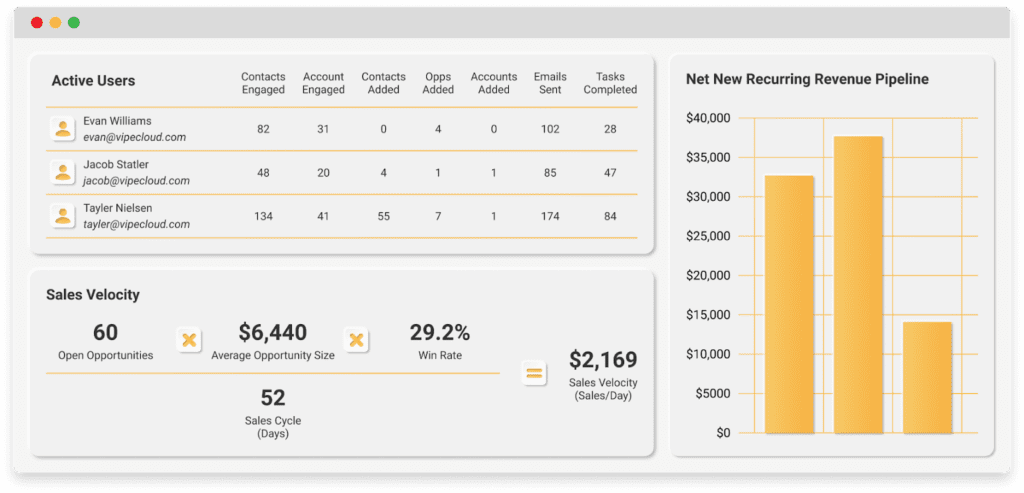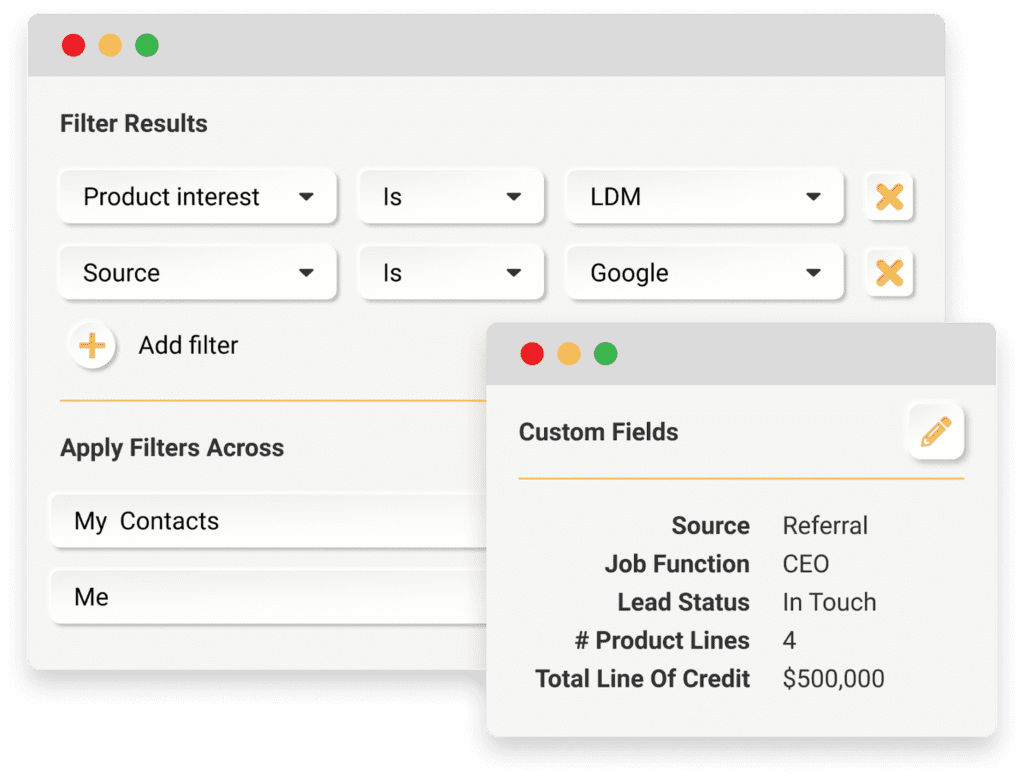Last updated on August 3rd, 2023

CRM and marketing automation are the perfect match for marketers looking to create a personalized marketing experience.
Think about it:
A CRM has the data necessary to better understand your customers.
And marketing automation helps you scale your lead generation efforts.
Combine the two, and you’ll have a system that is more efficient, effective, and produces more results.
Today, we’re going to peel back the veil as to why these two technologies are simply made for one another…
Because without them?
Your business may not be competitive enough to outshine competitors.
You’ll learn:
- What Is CRM Marketing Automation?
- How Is CRM Used In Marketing?
- 3 Reasons Why CRM And Marketing Automation Need Each Other
- The Cost Of Not Combining Marketing Automation And CRM
- 6 Best Practices For CRM Marketing Automation
- The #1 CRM And Marketing Automation Tool
 Automate All Your Communications With VipeCloud
Automate All Your Communications With VipeCloud
VipeCloud is the only Automation tool your small business needs to
be the hero to your customers.
With Email, Texting, Social, Suites, Chat, Stories, Video Email & Sign Up Forms fully built-in, we provide you with the perfect platform to grow your business.
15 Day Free Trial – Get started risk free. No CC needed.
What Is CRM Marketing Automation?
CRM marketing automation is when the data and insights from a CRM are integrated with marketing tools to market more effectively.
If you’ve been in the marketing and sales space, I’m sure you’ve come across the terms CRM and Marketing automation.
CRM (aka Customer Relationship Management) is software used to manage and keep track of customer data, needs, pipelines, and communications.
CRMs are like a toolbox for sales reps and are a powerful tool for maintaining customer relationships.
On the other hand, marketing automation is software that allows you to market on multiple platforms. It includes features like lead capturing, automated follow-ups, email automation, and more.
Businesses put marketing automation in place to save time on repetitive tasks and market at scale.
When you combine your CRM with marketing automation — you can market to leads and clients with more personalization, accuracy, and quality.
How Is CRM Used In Marketing?
Let’s give you a bigger picture understanding of how CRM is a significant part of a successful marketing strategy.
CRM Is A Marketing Data Hub
CRM is used as a data hub of valuable information for marketing platforms like: Email, social media, text messaging, and more.
Customer data is a marketer’s secret weapon.
Why?
The more customer research a marketer has in their toolbox, the more prepared they are to understand their ideal customer, which leads to higher quality leads.

Let’s look at how CRM plays a role in VipeCloud’s email newsletters.
Email newsletters can be segmented based on data from your CRM.
How?
When you send email newsletter campaigns to your list, you can see important metrics like open rates, link clicks, and more.
From there, you can consolidate the people that took different actions into their respective categories or “lists.”
Now you can segment them in your CRM based on the actions they performed. From there, you can tailor future marketing messages to them that are personalized!
For example, say you sent an email campaign relating to a course you’re releasing soon. And you took inventory of the people that clicked the CTA link but didn’t opt-in.
You can use your CRM to segment the people that haven’t yet converted.
Then,you can continue sending them emails to warm them up (like emails with more info, testimonials, or maybe a time-limited discount).
CRM is all about building relationships, and you’ve probably heard the adage:
“Relationships take time.”
As you market more and more, CRM is the tool that helps build rapport as time passes and before you know it….
You’ll be building long-lasting relationships with your customers!
3 Reasons Why CRM & Marketing Automation Need Each Other

Research has shown that CRM ROI can range from about $2.50 to upwards of $5.60 per EVERY dollar invested.

But besides the obvious ROI, here are three other reasons why your CRM and marketing tools should be working together.
1. More Productivity
Productivity is the name of the game if you want your team members to accomplish the most amount of tasks in the shortest amount of time.
And according to IBM, businesses using a CRM system see a 50% increase in productivity and a 40% reduction in labor overhead.
So what happens when you combine your CRM and marketing automation?
Having both all in one place means less time shuffling through and logging into different software in your tech stack .
Everything is centralized into one tool, which leads to more productivity in your business.
Not to mention the big cost savings, which is a huge deal to SMBs who need to watch where their money is going.
2. Seamless Data Integration
“It is a capital mistake to theorize before one has data.” — Sherlock Holmes.
Yes, I just quoted Sherlock Holmes because the quote really rings home.
The data you collect from marketing has more use cases in today’s world than you could imagine. And getting the most out of your marketing automation means housing your data securely in a CRM.
What can you do with this data?
The information on customer profiles, behavior, and needs can be used to understand them better and improve future marketing plans.
Contrast this with your competitor that maybe does an unsegmented email blast every once and a while, hoping for the best — you’re miles and miles ahead.
Vipecloud’s Marketing Suite & Sales CRM puts all your key marketing tools and metrics in one place to help your business be as successful as possible.
Whether it’s marketing sign-up forms, pipeline reports, or customer segmentation!
3. Sales Efficiency
Sales efficiency is the measure of speed at which your sales and marketing team converts prospects into paying customers.
Think of sales efficiency like the miles per gallon you get on a car — the more, the better.
But just like a car, there are times when you have to take a step back and check for problems and leaks.
CRM and marketing automation is the solution to business leaks because (again) data is present, and you have the tool to fix leaks (like a slow sales cycle, for instance).
Think about it:
Automation saves you time, and time is the determining factor of whether or not your sales process is efficient.
If you have a longer sales cycle than industry competitors, your sales numbers will likely suffer for it.
This means there are likely problems somewhere that you have to identify.
And this is where reports come in.

With a CRM like VipeCloud, you can see reports from team members to help identify where your team could need improvement.
The Cost Of Not Combining Marketing Automation & CRM
At this point, you likely see the big upsides of combining both CRM and marketing automation, but what about when you don’t?
Maybe you’ve experienced the following scenarios first-hand when you first started your business:
- Business leaks & lost data
- Slowed down workflows
- Company disconnect (sales department may not be on the same page as marketing department)
When you’re using one software to market and another for your main CRM, there’s a big chance that you have to re-enter previous data manually. And that’s not considering any mistakes made on you or your data entry person’s part.
This “manual” way of doing things leads to slower workflows, which is something you can’t afford to happen, especially when you’re scaling your business.
And here’s another part very few talk about:
You might even run into a “company disconnect.”
Here’s what I mean:
Having two major operations like marketing and sales on two different platforms can lead to communication issues between your marketing personnel and salespeople.
Maybe your separate marketing platform doesn’t have a lead scoring system, and your sales team is receiving unqualified leads.
Which causes your sales reps to spend time on uninterested buyers.
This disconnect can also manifest in numerous other ways, so fusing CRM and marketing automation is pivotal.
6 Best Practices For CRM Marketing Automation

1. Get As Much Data As Possible
The name of the game when it comes to CRM marketing automation is getting as much data on your customers as possible.
You can not only gather data online but also during your conversations.
Salespeople gather tons of information during calls and presentations that you may not typically get through a traditional “sign-up” form.
Using both technology and customer conversations will help you stack all the data necessary to learn about your prospects and improve your service (as we stated earlier).
2. Configure Your Tools

When using CRM and marketing automation all in one place, your tools need to be configured to best suit your business.
Look for a customizable CRM that lets you create multiple pipelines, edit custom fields and capture the data you want.
On the marketing automation side, you should have the ability to create lead generation campaigns through channels like email and social.
No two organizations are the same, so neither should their CRM customizations!
3. Use Multi-Channel Marketing
I get it — you’ve seen success in one way of marketing — maybe specifically email, or social media — and you want to just stick with that one method.
BUT, with a combined CRM and marketing automation tool, you’re not leveraging all the tools in your arsenal by doing this.
Multi-channel marketing helps you reach a wider audience within your niche by putting you in front of people that prefer a specific platform.
For example, some people really enjoy text message offers from their favorite companies but can’t stand receiving emails.
Others may like social media the most and hate the thought of getting on a phone call.
By using as many tools as possible to automate your marketing, you’re meeting people where they are in terms of communication preferences.
Multi-channel marketing also gives you more ways of re-targeting people that are consistently on multiple channels!
People that shop on multiple channels (B2C) are seen to have a 30% higher lifetime value than average!
The beauty of this form of marketing is that even if one mode becomes stale, you’ll have the reference experience (know-how) of knowing how to shift to a more relevant channel.
Lastly, creating marketing automations on multiple channels doesn’t mean spreading yourself thin.
Continually gauge which platform gives you the juiciest ROI and spend a bit more time on that one while still marketing on other channels.
Make sure you’re consistent in your messaging and end-goal. If you’re optimizing for more demo calls for example, that should show in your call-to-actions across your emails, SMS campaigns or social media posts.
This is known as direct response marketing (action-based marketing), which is what SMBs should be using over general brand awareness forms of marketing (general recognition marketing).
4. Segment Your Contact List

The power of your contact segmentation is unmatched.
Giving your contact list “tags” is one easy way to segment your leads and customers.
These tags categorize your leads or customers by industry, demographic behavior, needs, etc.
List segmentation allows you to stay organized and target your leads or customers with the right messaging.
In marketing, “right messaging” typically means that what you’re saying to a prospect or customer is personalized.
It means you’ve essentially “done your homework” on their needs/pain points, and your words articulate a powerful solution.
And when your marketing has the right messaging — your conversion rates will increase.
Epsilon research reported that 80% of consumers have a higher likelihood of making a purchase when a brand has a personalized experience.
This is a telltale sign of why marketing personalization is crucial, and it all starts with segmentation!
5. Remove Duplicate Data
Duplicate data is somewhat of a consistent problem people experience with CRM marketing automation.
What do I mean?
Well here’s an example:
Say “Robert” recently submitted your lead form and his data gets instantly synced into your CRM.
Awesome.
Robert is now considered a lead and he’s someone you’ll be follow-up with very shortly. However, Robert is so excited to potentially work with you, that he books a call using your website, and gets synced into the system AGAIN.
Robert has just been recorded as two separate people in your CRM (once from the sign-up form and once from the booked call).
This is known as duplicate data and it can lead to the following issues:
- Confusing communications – Which may cause you to send the wrong emails, texts and automations to your recipient.
- False positives & faulty data – This will cause you to think you have more unique leads or conversions than you actually do
- Data compliance issues – This could cause accidental violations to data guidelines of your region or industry (For example HIPAA for medical data or The European Union’s GDPR) due to sending multiple/too many marketing messages
You and your team should remove duplicate contacts consistently and add additional information that a duplicate had into the original.
Or, you should have used a CRM like VipeCloud that catches the duplicate data for you.
6. Analyze Data Consistently
I’m going to say it:
You could have the best CRM and marketing automation tool in the galaxy…
You could have the best team of marketing and salespeople in the universe…
But if you aren’t analyzing your data, you’re going to fall short of success. Know your numbers like the cost to acquire a customer, your customer lifetime value, leads per month, and conversion rate.
Analyze how your company is performing almost daily and be honest about where things could be improved.
It’s important to get second-hand feedback, maybe from someone that isn’t part of your company, a business friend, or an industry mentor.
The reason being is because they can give you an unbiased perspective of your company and help you improve.
The truth is, it’s very easy for us to have blinders on when running a business and we end up not seeing the not-so-great aspects of our marketing.
Analyzing should be a continuous process, and it should be in the form of sales and marketing reports.
Try The #1 CRM And Marketing Automation Tool
With all this info about CRM and marketing automation, there are clear reasons why small to medium-sized businesses should look to synergize the two.
It levels the playing field and allows them to market just as powerfully as the bigger guys.
VipeCloud is the all-in-one that combines your marketing, sales, and CRM.
The result?
Your marketing leads will turn into clients with a more powerful, personalized experience.
Our Marketing and Sales Suite has the tools you need to create powerful marketing automation (everything from email newsletters, sign-up forms, social media sharing, and reports).
Improving your CRM marketing automation with VipeCloud is your one-stop shop for a faster sales cycle and more revenue.
Joining us from another CRM? We’ll help you migrate your data!
Try our Marketing & Sales Suite and get your first 15-days free.
Have some questions? We’ll be glad to give you a demo!

Leave a Reply